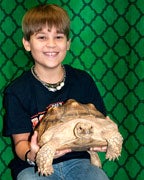Barn Hill Preserve Visits HIS
Published 2:51 pm Monday, March 31, 2014
By LAURA BROOKHART / Community Columnist
Barn Hill Preserve was founded in 2013 to educate and inspire the public about wildlife, exotic animals, and the environment. Getting up close and personal with an array of unique animal ambassadors provided an unforgettable experience recently for students at Helena Intermediate School.
Barn Hill is located in Ethel, La. In addition to animal education and entertainment Barn Hill holds permits to rehabilitate native wildlife and provides sanctuary for exotics with a focus on large parrots.
During his visit to HIS, founder Gabriel Ligon first presented a young boa, a naturally camouflaged reptile that kills it prey by squeezing or injecting venom.

Student Tanner James chose to have his photograph made with the African spurred tortoise during the Barn Hill Preservation visit at HIS. (Contributed)
Next was the tortoise, a terrestrial native of Northern Africa, that can weigh from 2 -75 pounds. It is the world’s third largest species of tortoise, after the Galapagos (200 pounds) and Aldabra giant tortoise.
The tortoise has only one shell for life, unlike the hermit crab. Its shell protects from top, side, bottom, but not the face. When it draws its head and legs in, the spurs continue to act as a weapon of defense.
Ligon answered questions as well, such as what happens when two tortoises fight—they try to flip one another over and it’s very hard for them to right themselves after, so they may die, if not righted. The shell can bleed, he added, and wildlife rehabilitators can use special glue to help a shell repair itself.
Porcupines are not scared of anything, Ligon noted, displaying Stella, an abandoned porcupine that was bottle-fed and is comfortable around humans.
“Stella eats root vegetables and her teeth never stop growing,” Ligon told his audience. “A porcupine quill can kill another animal if quill gets stuck in face and prevents that animal from eating.”
Outright amazement was on every face as the 1-year old bottle-fed Kinkajou was introduced. The Kinkajou likes to hang from trees and drink nectar. They have a golden underbelly that earns them the nickname of “honeybear.”
“It’s a secretive (nocturnal) animal that makes it hard for scientists to study him,” Ligon said. “In captivity, they may live for up to 23 years,” he said.








